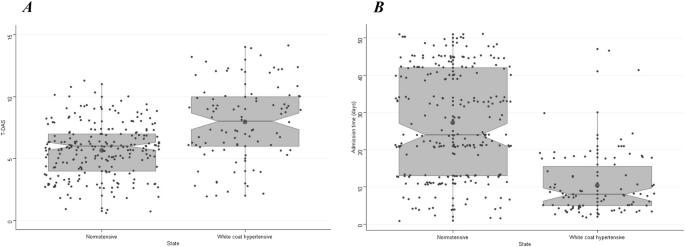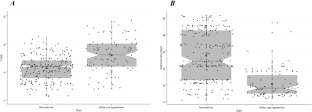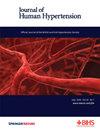Templer’s death anxiety scale on the relationship between white coat hypertension and anxiety: A cross-sectional study
IF 2.7
4区 医学
Q2 PERIPHERAL VASCULAR DISEASE
引用次数: 0
Abstract
The relationship between white coat hypertension (WCH) and anxiety remains not fully elucidated. This study aims to investigate the correlation between WCH and Templer’s Death Anxiety Scale (T-DAS) questionnaire. Asymptomatic individuals with a familial history of sudden cardiac death or acute myocardial infarction within the last year, who presented at our cardiology outpatient clinic, were enrolled in this prospective, single-center, cross-sectional study. Among those with elevated blood pressure in the outpatient clinic setting, participants were categorized into normotensive and WCH groups through 24-hour ambulatory blood pressure monitoring. Demographic features, laboratory parameters, and T-DAS scores were documented. Logistic regression and sensitivity analyses were conducted to ascertain WCH occurrence. Among 324 consecutive participants, 90 were diagnosed with WCH. T-DAS scores were significantly elevated in the WCH subgroup, particularly among those seeking early medical attention following bereavement. Multivariable logistic regression highlighted gender, BMI, heart rate, T-DAS, and admission time as independent correlates of WCH. Significantly, T-DAS exhibited the third most substantial contribution to the regression analysis, following admission time and heart rate. The multivariable logistic regression analysis incorporating T-DAS exhibited high robustness, discrimination, fit, and calibration, with a Brier score of 0.106, adjusted R2 of 0.576, and C-statistic of 0.905 (95% CI: 0.871–0.940, p < 0.001). T-DAS, with a threshold of >8, demonstrated 48% sensitivity and 90% specificity in detecting WCH. Additionally, decision curve analysis verified that the model including T-DAS offers a net benefit in detecting WCH. This study unveils a potential association between WCH and death anxiety.


关于白大衣高血压与焦虑关系的 Templer 死亡焦虑量表:一项横断面研究。
白大衣高血压(WCH)与焦虑之间的关系仍未完全阐明。本研究旨在探讨白大衣高血压与Templer死亡焦虑量表(T-DAS)问卷之间的相关性。这项前瞻性、单中心、横断面研究选取了在过去一年内有心脏性猝死或急性心肌梗死家族史的无症状患者作为研究对象。在门诊血压升高的患者中,通过 24 小时动态血压监测将其分为血压正常组和 WCH 组。研究记录了人口统计学特征、实验室参数和 T-DAS 评分。为确定 WCH 的发生率,进行了逻辑回归和敏感性分析。在 324 名连续参与者中,有 90 人被确诊为 WCH。WCH亚组的T-DAS评分明显升高,尤其是在丧亲后及早就医的人群中。多变量逻辑回归强调了性别、体重指数、心率、T-DAS 和入院时间与 WCH 的独立相关性。值得注意的是,继入院时间和心率之后,T-DAS 对回归分析的贡献排在第三位。包含 T-DAS 的多变量逻辑回归分析具有很高的稳健性、区分度、拟合度和校准性,其 Brier 评分为 0.106,调整后 R2 为 0.576,C 统计量为 0.905(95% CI:0.871-0.940,p 8),在检测 WCH 方面具有 48% 的灵敏度和 90% 的特异性。此外,决策曲线分析证实,包含 T-DAS 的模型在检测 WCH 方面具有净获益。本研究揭示了 WCH 与死亡焦虑之间的潜在联系。
本文章由计算机程序翻译,如有差异,请以英文原文为准。
求助全文
约1分钟内获得全文
求助全文
来源期刊

Journal of Human Hypertension
医学-外周血管病
CiteScore
5.20
自引率
3.70%
发文量
126
审稿时长
6-12 weeks
期刊介绍:
Journal of Human Hypertension is published monthly and is of interest to health care professionals who deal with hypertension (specialists, internists, primary care physicians) and public health workers. We believe that our patients benefit from robust scientific data that are based on well conducted clinical trials. We also believe that basic sciences are the foundations on which we build our knowledge of clinical conditions and their management. Towards this end, although we are primarily a clinical based journal, we also welcome suitable basic sciences studies that promote our understanding of human hypertension.
The journal aims to perform the dual role of increasing knowledge in the field of high blood pressure as well as improving the standard of care of patients. The editors will consider for publication all suitable papers dealing directly or indirectly with clinical aspects of hypertension, including but not limited to epidemiology, pathophysiology, therapeutics and basic sciences involving human subjects or tissues. We also consider papers from all specialties such as ophthalmology, cardiology, nephrology, obstetrics and stroke medicine that deal with the various aspects of hypertension and its complications.
 求助内容:
求助内容: 应助结果提醒方式:
应助结果提醒方式:


